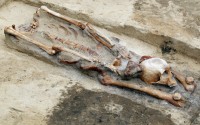 Archaeologists excavating the site of future road construction near the town of Gliwice in Silesia, southern Poland, discovered four skeletons buried with their heads between their knees. Stones were placed on the skulls. Further digging unearthed another nine skeletons buried with their heads out of place. Eleven were found with the skull between the legs, one with skull between the hands, two with the skull perched directly on the shoulders. Most of the skeletons found buried this way appear to be female.
Archaeologists excavating the site of future road construction near the town of Gliwice in Silesia, southern Poland, discovered four skeletons buried with their heads between their knees. Stones were placed on the skulls. Further digging unearthed another nine skeletons buried with their heads out of place. Eleven were found with the skull between the legs, one with skull between the hands, two with the skull perched directly on the shoulders. Most of the skeletons found buried this way appear to be female.
Putting the head anywhere but on top of the neck was a common folk practice in Slavic countries for ensuring that the dead would not rise from the grave to harry the living. The idea was that if the dead person attempted to rise, without her head in place she wouldn’t be able to see his victims or even coordinate the climb out of the grave. Other practices — binding feet and hands, pressing with a heavy boulder, pinning the body to the ground by embedding an object in the chest — were also used to ensure the undead would not be able to budge.
 Fear of vampirism is not the only possible explanation for the burials, however. There was a gallows near the site of the graveyard. In the Middle Ages, the executed were sometimes left to hang until their corpses rotted and the head disconnected from the body. The decomposed body would then be buried with the head deliberately not placed atop the neck because convicts didn’t deserve a decent burial. That’s not mutually exclusive with the vampirism hypothesis. Locals would have good reason to ensure those executed and left to rot didn’t come back to seek revenge. The deceased might also have been victims of a mass killing — a battle or slaughtered civilians — during the turbulent times of the early Middle Ages, or of a cholera epidemic.
Fear of vampirism is not the only possible explanation for the burials, however. There was a gallows near the site of the graveyard. In the Middle Ages, the executed were sometimes left to hang until their corpses rotted and the head disconnected from the body. The decomposed body would then be buried with the head deliberately not placed atop the neck because convicts didn’t deserve a decent burial. That’s not mutually exclusive with the vampirism hypothesis. Locals would have good reason to ensure those executed and left to rot didn’t come back to seek revenge. The deceased might also have been victims of a mass killing — a battle or slaughtered civilians — during the turbulent times of the early Middle Ages, or of a cholera epidemic.
There were no grave goods, not even the remains of clothing like buttons, in the initial discoveries that could give an idea of when they were buried. The ritual was in regular use in Poland from the arrival of Christianity in the 10th century until the First World War (the last known vampire burial in Poland took place in the east-central village of Old Mierzwice in 1914), so that doesn’t help narrow it down. Finally on Thursday, July 18th, archaeologists found a female skeleton buried with two small artifacts. They may be the key to dating these burials. Her bones were also charred, indicating deliberating burning.
Researchers are analyzing the remains now which will hopefully pinpoint a burial date and possible causes of death. Osteological examination has already returned extraordinary results: the eye sockets are much larger than average while the nasomaxillary area (the part between the nose and the upper jaw) is narrower than average. This would have given them a cat-like appearance, a genetic mutation that suggests the deceased are related and that might explain why this group of people were seen as dangerous by their community.